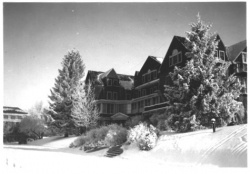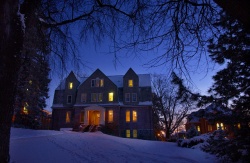Personal tools
Help
Tools
Class Notes
- Do you have news for fellow WSU alumni and other readers of Washington State Magazine? Send us your class note.
Our Story
written by alumni, faculty and friends.
NOTE: THIS IS A LEGACY SITE AND IS NOT REGULARLY MAINTAINED
Views
The Legend of the Black Cat
From Our Story
Sundry persons returning late at night, as they approached the Hall, had been startled by a whisk and a vanish, and, staring into the darkness, could see nothing and feel nothing, except that prickling sensation which one has when she combs the hair with a rubber comb on a frosty morning. A few persons had caught a glimpse of a flash of blackness into a hole under the porch, and, peering in, could see nothing except two bright spots far back under the floor joists. Occasionally a couple returning late at night to the west entrance (that was in the golden past before an electric light had been installed on the west porch) could see between the porch vines two shining orbs like coals of fire, which left the shivering pair in uncertainty whether the phosphorescence came from the eyes of the legendary black cat that dwelt under the house, or from the eyes of the presiding genius who dwelt above the first floor.
Sometimes, from back of the Hall, just after the lights were out (and in those days the lights were shut off at the plant at 10:30, and no other light than a tallow dip might be used until dawn) the girls living on the east side of the house would be startled by a piercing cry from without, at once plaintive, sorrowful and full of longing, as though it were uttered in the hope of a far-off response from some lost but sympathetic soul. Windows would go up and many pairs of eyes would be strained into the darkness to catch the source of this cry of anguish and of longing, but nothing could be seen, and nothing further heard.These and numerous other indications of an inhabitant of the Hall not regularly admitted, not received into the inner circle, and not obeying the rule in regard to late hours, were told from time to time, late at night when the girls sat upon the floor with the lights all out, save a flickering blue flame on the hearth.
The experience of one and another in regard to the black cat were related from time to time, with that delightful and uncanny reaction which girls like so well at such times. This continued until, on one such occasion, one of the girls remarked,
“I wish you wouldn’t mention the black cat again, for it always makes me think of poor Susanne.”
A shiver went round the circle, just as though an icy blast had struck them from some window left accidentally ajar. Thenceforward, the black cat was referred to only in lowered tones, or in whispers.
For just about the time the first rumors of the black cat began to be heard, or a little earlier than that date, Susanne had left the Hall. She always had been a queer girl, rather tall, a decided brunette, ink-black eyes, straight, black hair, an ivory neck and forehead, a pensive look about her eyes, and not inclined to join much in the merriment of the Hall. She went little to social affairs. Once or twice a youth had called upon her in the afternoon, but no one except the preceptress had seen him, and she had said that he was a handsome lad, but that she didn’t like his eye.
For some reason or other, the preceptress had been rather hard on Susanne, so the girls thought, and had had more than one interview with her in the preceptress’ room (for that was the days before there was an office). One of the girls bumped into Susanne one day as she was coming from the President’s office. She noticed that Susanne’s eyes were red. Evidently she had been crying; and so preoccupied was she that she did not notice anyone until the collision, and then only said. “Beg pardon” and hastened on.
The next day when someone said, “Where is Susanne?” the preceptress replied as though it were the most ordinary matter, “Susanne went home today. Her folks sent for her. There seems to be trouble in the family. I hardly think she will be back this semester.”
The girls would have forgotten Susanne and her queer manner quickly had it not been that sometime afterward there came a newspaper story from the remote part of the state in which Susanne lived that, soon after her return from college, she had suddenly disappeared, and that no trace of her had ever been found. Search was made and inquiry at the nearest railway station without success. One of the girls had met a man from that part of the state who knew of the circumstances and said it was very mysterious, but that if things could only tell their story he believed that a lake very cold and deep in that region, which people living there said had no bottom, could throw light upon the subject.
How the imagination of the one girl in the Hall who said that the black cat story always reminded her of poor Susanne could ever have led her to see any connection between two things so utterly unlike, is one of the mysteries that belong to girl psychology; but no sooner had it been suggested than it sank into the life of the Hall, and never was the one mentioned without thought of the other flashing upon the mind.
The nervous state thus engendered appeared only when something unusual occurred. One of the girls who roomed on the second floor, south end, near the stairway, heard more than once, soft steps apparently of someone coming up the stairway from the hall below, and continuing on up to the attic floor; and no matter how intensely she might listen could she hear anything more. She told the preceptress about it once but she scoffed at her and told her that it was probably that black cat prowling about, and that she oughtn’t to make herself nervous about nothing.
In those good old days, the top floor was an attic, all in one great room. Only the rough floor had been laid and in this “House of Seventeen Gables”, as Stevens Hall has been called, there were in the attic, many nooks and cobwebbed corners where trunks and boxes were piled high and where discarded mattresses and broken down rockers were stowed away. Susanne’s mattress, like the rest of the relics was doubtless among these.
The girls often had occasion to go to the attic to get something out of the trunks or put something away until the close of the year, and it must be admitted that on such occasions the footsteps did resound unusually loud, and the girl, if she went alone, which she seldom did, did not stay any longer than was necessary, but hurried back to her room.
One night when the wind was shrieking through the chinks in the attic like a concert of lost souls, there was a crash in the attic, as of something falling, followed by a tramp, tramp, tramp, as of a person walking heavily across the attic floor. The crash had awakened several of the girls on the second floor, and the heavy tread had startled them into wide-awakefulness and fear. Tallow dips were lighted and two of the boldest hurried down to the bedroom of the preceptress, followed part way by a straggling throng of those first awakened and others aroused by the commotion in the hallways. The preceptress was informed that there was a man in the house and that several of the girls had plainly heard him walking across the attic floor.
“A man in the attic”, was whispered from lip to lip and from floor to floor. Soon a white-robed procession, headed by the preceptress with a broom in her hand, each member of the procession bearing aloft the little tallow dip, extended from the top of the north stairway next the attic floor, down the long stairway to the lower hall and along the hallways. The attic door was very slightly ajar, just unlatched, but not open. There was a moment of breathless suspense before the real attack should begin, the preceptress still insisting that the girls were mistaken and that it was just their own silly brains that had conjured up the man. The door was quietly pushed open with the broom.
Suddenly, high in the air above the heads of everyone, a fierce black object like an embodied spirit, its eyeballs of fire, its four legs spread wide and its long black tail of enormous size, with furious spits and growls, landed on the first platform, and, now on this side, now on that, with scratch and scramble and redoubled spits and yawls flew down the stairway amid the wrecks of the procession. Every light was out. Blood curdling shrieks pierced the air from the first appearance of the black spirit overhead. Total darkness reigned supreme above the pandemonium. There were no candles to be recovered, no matches to light them with, and no place to scratch them if there had been any matches to scratch. There was no telephone in the hall in those days.
Tremblingly, the white-robed throng crept back, each to her shivering bed, No one ever knew that night what became of the preceptress. Few cared.
The next day Mr. Grimes was ordered from the President’s office to close with a close wire screen, every opening under the porch and to do so during the day, and to keep a sharp watch, and if any noisome odors arose from beneath the house, to investigate and immediately remove the nuisance. The black cat was never seen nor heard of afterward.
Our Story site map
Our Story main page | Our Story categories | Help Desk
Contact | Give | Advertise
Washington State Magazine | Washington State University | Class Notes
Our Story is coordinated by
In partnership with
Our Story and Washington State Magazine are publications of Washington State University. All rights reserved.
P.O. Box 641227, Washington State University, Pullman, WA 99164-1227 USA | wsm@wsu.edu, 509-335-2388
Accessibility | Copyright | Policies


